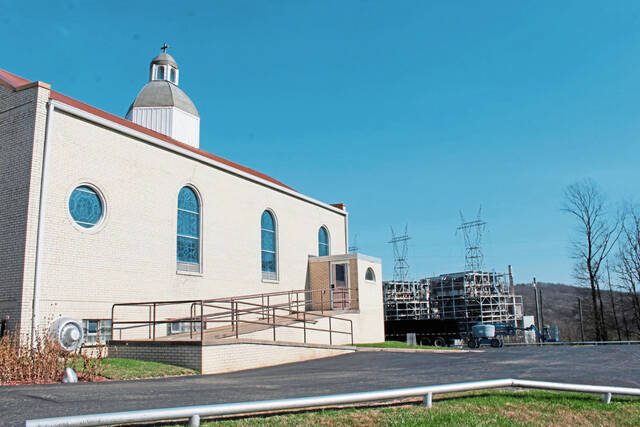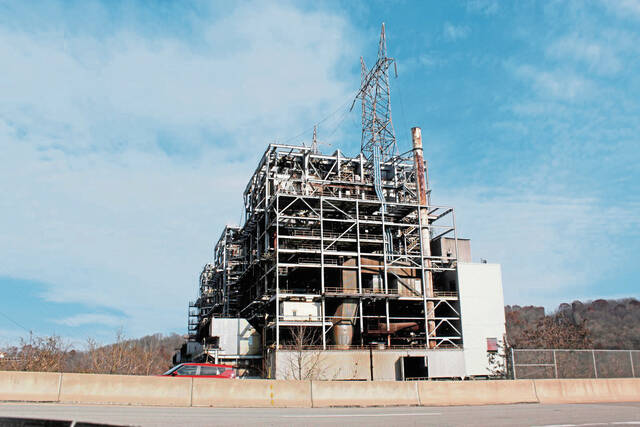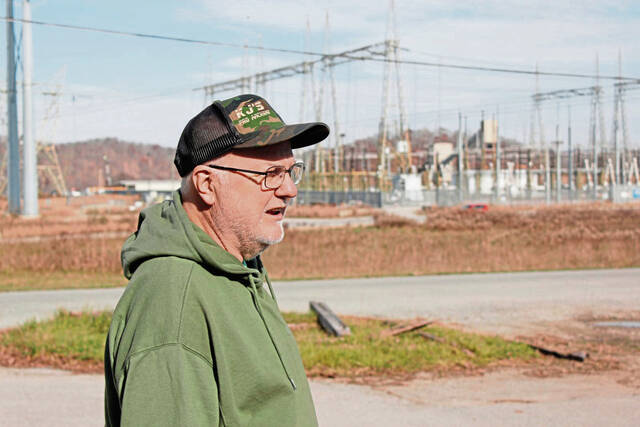Hatfield’s Ferry power plant demolition embodies end of a bygone era
Masontown council President Bruce Cochrane can remember when the power station at Hatfield’s Ferry was built.
A longtime resident of the borough at the border of Fayette and Greene counties, the retired UPS driver has spent most of his life driving on the bridge that crosses the Monongahela River and seeing the plant looming on the skyline.
It was built in the late 1960s and closed in 2013. But the buildings remained.
“They couldn’t take the big generator over the bridge, so they went to the right,” Cochrane recalls of the plant’s construction. “People were lined up — it looked like a parade. People just wanted to see all of it.”
Some of those same people may line up Friday when contractors implode what remains of the former 1,710-megawatt power plant.
At 11 a.m., the boiler house, which once contained the power-generating turbines and is the last remaining major structure on site, will be imploded. According to FirstEnergy, the building is a shell with much of the generation equipment removed and scrapped. Standing about 250 feet tall, it’s expected to topple mostly within its own footprint.
FirstEnergy spokesperson Todd Meyers said the plant is being removed to ready the property for a return to productive economic use, though there are no concrete plans for the site.
The larger and taller structures on the 236-acre site were already demolished this year by the company. Two concrete hyperbolic cooling towers — 500 and 550 feet tall — were imploded June 8. Three emissions stacks — two 700 feet tall and one 540 feet tall — came down March 4.
“Since it was shuttered, it was just a big eyesore,” Cochrane said. “It’s nice to have it come down.”
Lost jobs, lost era
For many of Masontown’s 3,200 residents and other locals, the memory of the plant’s closure isn’t a positive one.
FirstEnergy said the plant employed about 190 people when it closed.
“At the time, the estimated cost to comply with new and proposed federal environmental regulations, coupled with low market prices for electricity, prompted the difficult decision to deactivate the plant,” a statement said.
Kevin Polish Sr., who works at KJ’s Pro Archery on the Greene County side of the river, said he had a good friend who was third in seniority at the plant for years.
“It’s just disappointing. It was like a shock,” he said. “You never thought, how could they lose their jobs?”
A lifelong area resident, his father would tell Polish that in his day, the area around the power plant had fields on both sides. Polish has heard positive and negative takes on the plant’s closure — some who lamented the loss of jobs and others who were relieved to avoid potential environmental or health hazards.
“It’s all over after this,” he said. “They’re just like landmarks, and they’re all gone. The sad thing is on the monetary side — so many friends, customers and relations lost their jobs.”
Tammy Cowsert of Masontown was in junior high school when the plant was built.
“I knew some people from my church who worked there,” she said, noting that the closure “kind of ticked off” the locals.
“It really affected here,” she said.
Kaitlyn Vance’s family moved from Smithfield to Masontown 10 years ago.
“The neighbors we had behind us got laid off, and they ended up moving just as we were moving in, because they had to find another job,” Vance said.
For Cochrane, the closure of the plant evokes complicated feelings about the evolution and changing nature of industry in the region, once known for its coal mines. He has his own frustrations about government regulation of energy, as well as the profits that large companies make from a region that can also see negative environmental impacts from resource extraction.
Then, there’s the many people who lost their jobs in the closure, some of whom left town.
“It displaced some workers, who had a lot of years there,” he said. “It was a good-paying job — good benefits, good pay, and the work wasn’t that bad. But it’s always a dangerous job,” he added, noting several workers died at the site during the plant’s history.
As borough council president, he’s made it part of his mission to try to leave the town better than he found it. Masontown has faced blight, and has 70 or 80 abandoned houses that are being gradually addressed by the borough. A streetscape grant program is ongoing and will bring a revitalized main street area to the community within the next few years.
“When I was a kid, it was booming here. You had your bakeries, your stores, the hardware store. It was just amazing — this was the place to be, besides Uniontown,” he said. “Things change, people moved on. If you go through town, you’ll see a lot of shuttered buildings … It’ll never be what it was.”
A gap in the landscape
Many residents watched the previous two demolitions this year from a distance — some from the road, some from the woods across the river in four-wheelers, and some even from the roofs of their houses.
Polish said the lot of the archery store and the road leading to and from the bridge were packed with people earlier this year to watch the plant’s towers tumble.
Masontown truck driver Chad Bergman has a video on his phone of the two cooling towers coming down, taken by a family member. The structures crumble into dust — there one moment, falling the next.
“I used to look at the towers daily when I left my house,” he said. He knew about a dozen people who used to work at the plant.
The station looms large in recent and past memory, even though it’s been closed for 10 years.
Cochrane recalls the banner that Greenpeace protesters hung high up at the plant in 2004, proclaiming their anger over then-President Bush’s energy policy. The 2,500-square-foot banner, hung from a smokestack 700 feet in the air, read, “The Bush Energy Plan Kills — Clean Energy Now!”
Cochrane could see the banner from his boat down on the Mon.
“You could just hear (the barges) pounding down there all night long, and you could always hear the intercoms, guys talking” he said, of the plant’s operating years. “It wasn’t crazy noisy, but it was noisy.”
John David, a Masontown resident, said his late father, James Lininger, worked as a security guard at the plant in the 1990s.
“He worked early or late hours,” David said. “I used to take him his lunch when he forgot it. He worked at the first gate.”
His father moved to a different plant and retired from there, but David can still remember swimming in the river under the bridge and looking up at the plant.
“I liked looking at the stacks, and at night, when the lights were flashing,” he said of the plant’s operation. “It’s going to look weird (when it’s gone).”
Darlene Baer, a Masontown resident, knew some people who used to work at the plant left town after losing their jobs.
“It’s always been there, ever since I was little,” she said. “It’s like a historical monument … I remember when it was in full operation, and now it’s this dead spot.”
Julia Maruca is a TribLive reporter covering health and the Greensburg and Hempfield areas. She joined the Trib in 2022 after working at the Butler Eagle covering southwestern Butler County. She can be reached at jmaruca@triblive.com.
Remove the ads from your TribLIVE reading experience but still support the journalists who create the content with TribLIVE Ad-Free.










